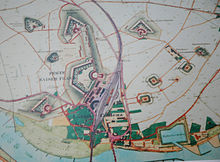Moselflesche

The Moselflesche was part of the Prussian fortress Koblenz and belonged to the Feste Kaiser Franz system . From 1822 in what is now Koblenz district Lützel completed Flesche are to eliminate the above-ground fortifications 1903 and the razing survived 1922 only small remnants. It is named after the river Moselle .
history
The Moselflesche was built in the years 1816/17 to 1822 on the south side of the Petersberg , an elevation on the left side of the Moselle. Like the Bubenheimer Flesche , it was connected to the main works, the Emperor Franz Fortress , via a hollow corridor. The front of the Flesche was directed to the west with a long face in the north and a short one parallel to the Moselle. A reduit in the shape of a semicircle lay in the throat on the east side.
After the abandonment in 1890, the garrison steam washing facility and the corps clothing office of the VIII Army Corps were built here , for which in 1903 most of the above-ground fortifications such as the Reduit and the wall were removed.
After the First World War, this Flesche too, like the other fortress works in Koblenz, had to be deconsolidated in accordance with the provisions of Article 180 of the Versailles Treaty . In the course of this work, a shoulder caponier and log cabin were removed from around the end of March or beginning of April to July 1922 . The entire area with all buildings became the property of the city of Koblenz at the end of 1918. However, first the American and later the French occupation claimed the area (as Caserne Valmy ), so that the city could only access it after 1930. In 1936, however, took Wehrmacht the building complex, which now Langemarck Barracks was called and the first, the pioneer - battalion was housed 34th
During the Second World War , the barracks burned down after a bomb attack . However, the damage was not so severe that the buildings should have been demolished. A tragedy occurred on December 28, 1944, when the communication to the Kaiser Franz festivals , used as an air raid shelter , received a direct hit. Over thirty people were killed. The remains of this tunnel were removed when the B 9 was lowered at the end of the 1960s.
After the end of the war, the French army again took over the complex as Quartier Général Frère , which after their withdrawal in 1969 fell back to the city of Koblenz. Until 1977, the city's registration office was housed here in some buildings. Since 1980 the building has housed the Defense Technical Study Collection (WTS).
The last visible remains of the Moselflesche can be seen today at the elementary school in Lützel and the Lützel kindergarten. Remnants of the wall can also be seen behind the houses in Weinbergstrasse. Here, in 1992, parts of the southern face with escarpe, including the circular corridor behind it and the rear buttresses, were restored and the top of the wall was protected with a zinc sheet roof. In addition, there are probably a large number of hollow passages on the site, which, however, cannot be visited.
Due to the risk of collapse, a section of the former closing wall of the Moselflesche on the Moselle side was renovated from the end of 2014 to the spring of 2015, whereby the interests of monument protection should be taken into account.
Monument protection
The remains of the Moselflesche are a protected cultural monument according to the Monument Protection Act (DSchG) and entered in the list of monuments of the state of Rhineland-Palatinate . They are located in Koblenz-Lützel at (near) Mayener Straße 85, Weinbergstraße .
The remnants of the Moselflesche have been part of the UNESCO World Heritage Upper Middle Rhine Valley since 2002 .
literature
- Klaus T. Weber (dissertation): The Prussian fortifications of Koblenz (1815–1834) . (Series: Art and Cultural Studies Research) 2003, ISBN 3-89739-340-9 .
- Rüdiger Wischemann: The Koblenz Fortress. From the Roman fort and Prussia's strongest fortress to the largest garrison of the German armed forces , Koblenz 1978 (note: outdated in many ways, but still the best representation for an overview).
- Sabine Bauer / Matthias Kellermann: The Moselflesche since 1900: laundromat, clothing office, Langemarckkaserne , in: Feste Kaiser Franz. On the history of the fortification and the Feste Franz system in Koblenz-Lützel. Festschrift for the 10th anniversary Feste Kaiser Franz eV, ed. von Feste Kaiser Franz eV, Koblenz 2008, pp. 56–64, ISBN 978-3-934795-55-6 .
- Matthias Kellermann: New research on the festivals Kaiser Franz and the system Franz , in: Feste Kaiser Franz ... a part of the fortress Koblenz and Ehrenbreitstein, ed. von Feste Kaiser Franz eV, Koblenz 2009, pp. 25–33.
- Ulrike Weber (edit.): City of Koblenz. City districts (= monument topography Federal Republic of Germany . Cultural monuments in Rhineland-Palatinate. Vol. 3, 3). Werner, Worms 2013, ISBN 978-3-88462-345-9 .
- Matthias Kellermann: Koblenz Fortress and Ehrenbreitstein. Deconsolidation 1920-1922 - photographs by Joseph Ring. Koblenz 2018, ISBN 978-3-95638-413-4 .
Web links
Individual evidence
- ↑ See part of the old Moselflesche is being renovated . In: Rhein-Zeitung . No. 243 , October 20, 2014, p. 11 . and children from the Maria Hilf day care center can play outside again . In: Rhein-Zeitung . No. 124 , May 30, 2015, p. 14 .
- ^ General Directorate for Cultural Heritage Rhineland-Palatinate (ed.): Informational directory of cultural monuments - district-free city of Koblenz. Mainz 2020, p. 26 f. (PDF; 6.5 MB).
Coordinates: 50 ° 22 ′ 4.5 ″ N , 7 ° 35 ′ 7.4 ″ E
